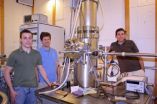NIH grantees find dengue affects genes, function of mosquito salivary glands
Changes promote blood-feeding behavior and virus transmission
2012-04-02
(Press-News.org) WHAT:
Mosquitoes infected with dengue virus experience an array of changes in the activity of genes and associated functions of their salivary glands, and these changes may lead to increased virus transmission, according to a recent study led by George Dimopoulos, Ph.D., of the Malaria Research Institute and Bloomberg School of Public Health at Johns Hopkins University. Some of these changes involve the mosquito's immune system and affect its susceptibility to infection with the virus. Others involve factors that enhance the mosquito's capacity to feed on blood, possibly leading to greater transmission of dengue virus to humans, the study authors write.
According to the World Health Organization, each year, dengue virus infects about 50 million to 100 million people and causes between 10,000 and 15,000 deaths, most of them in children. Symptoms include high fever and pain in the muscles and joints, and in severe cases can include bleeding under the skin, damage to blood vessels and death. The disease, which is prevalent in tropical and subtropical regions of the world, has been reported recently in parts of the United States, such as Hawaii, Puerto Rico and Florida. There is no vaccine or drug treatment for dengue. The only way to prevent infection is to avoid being bitten by Aedes mosquitoes, which can carry the virus in their salivary glands.
The Hopkins researchers sought to learn how dengue virus affects the way the glands function during virus transmission. They compared the expression of several thousand genes in Aedes aegypti mosquitoes that either were or were not infected with dengue virus. The researchers found that dengue infection triggered increased activity of 130 salivary gland genes, including genes with functions such as enabling the spread of virus between cells, destroying the mosquito's immune system cells and making blood feeding more efficient.
Through further experiments, the researchers found three salivary gland genes that modulate dengue virus infection of mosquitoes and two olfactory genes that help control the way mosquitoes search for and bite humans. Future studies should address the roles and functions of these and other genes that are triggered by dengue infection, the investigators write.
### The study was supported by the National Institute of Allergy and Infectious Diseases (NIAID), part of the National Institutes of Health.
ARTICLE:
S Sim et al. Dengue virus infection of the Aedes aegypti salivary gland and chemosensory apparatus induces genes that modulate infection and blood-feeding behavior. PLoS Pathogens DOI: 10.1371/journal.ppat.1002631 (2012).
WHO:
Adriana Costero-Saint Denis, Ph.D., vector biology program officer in NIAID's Parasitology and International Programs Branch, is available to discuss this study.
CONTACT:
To schedule interviews, please contact Nalini Padmanabhan, (301) 402-1663, padmanabhannm@niaid.nih.gov.
For more information about NIAID's research on dengue and other vector-borne diseases, visit the NIAID Web portals on Dengue and Vector Biology.
NIAID conducts and supports research—at NIH, throughout the United States, and worldwide—to study the causes of infectious and immune-mediated diseases, and to develop better means of preventing, diagnosing and treating these illnesses. News releases, fact sheets and other NIAID-related materials are available on the NIAID Web site at http://www.niaid.nih.gov.
About the National Institutes of Health (NIH): NIH, the nation's medical research agency, includes 27 Institutes and Centers and is a component of the U.S. Department of Health and Human Services. NIH is the primary federal agency conducting and supporting basic, clinical, and translational medical research, and is investigating the causes, treatments, and cures for both common and rare diseases. For more information about NIH and its programs, visit http://www.nih.gov/.
NIH...Turning Discovery Into Health
ELSE PRESS RELEASES FROM THIS DATE:
2012-04-02
Boulder, Colorado, USA – The April/May GSA Today science article is now online at www.geosociety.org/gsatoday/. In this issue, Simon Williams and colleagues from the Earthbyte Group of the School of Geosciences at the University of Sydney present GPlates, a powerful new method for analyzing geological and geophysical data sets within the context of tectonic reconstructions.
GPlates is part of a new generation of plate reconstruction software that incorporates functionality familiar from GIS software with the added dimension of geological time. By enabling the user to ...
2012-04-02
Graphite, more commonly known as pencil lead, could become the next big thing in the quest for smaller and less power-hungry electronics.
Resembling chicken wire on a nano scale, graphene – single sheets of graphite – is only one atom thick, making it the world's thinnest material. Two million graphene sheets stacked up would not be as thick as a credit card.
The tricky part physicists have yet to figure out how to control the flow of electrons through the material, a necessary prerequisite for putting it to work in any type of electronic circuit. Graphene behaves very ...
2012-04-02
Amsterdam, NL -- Investigators from the University of Amsterdam, Netherlands, have shown that in most elderly patients invasive and expensive techniques, i.e. lumbar puncture and PET scan, are not useful to establish the diagnosis of Alzheimer's disease. They arrived at this conclusion after analysis of data from the Alzheimer's Disease Neuroimaging Initiative (ADNI), a large collaborative research project of medical centers in the USA and Canada.
The Dutch researchers divided the ADNI sample into two halves, a younger (74 y). They showed that the CSF biomarkers (amyloid ...
2012-04-02
London -- New strategies injecting cardiovascular disease (CVD) patients with vaccines and monoclonal antibodies to combat atherosclerosis could soon change the treatment landscape of heart disease. Both approaches, Professor Jan Nilsson told delegates at the Frontiers in CardioVascular Biology (FCVB) 2012 meeting, can be considered truly ground breaking since for the first time they target the underlying cause of CVD. The FCVB meeting, organised by the Council on Basic Cardiovascular Science (CBCS) of the European Society of Cardiology (ESC), held 30 March to 1 April at ...
2012-04-02
Children who develop asthma by age seven have deficits in lung function and increased bronchial responsiveness as neonates, a new study from researchers in Denmark suggests.
"Previous research on the relationship between neonatal lung function and the development of asthma has been conflicting," said lead author Hans Bisgaard, MD, DMSci, professor of pediatrics at the University of Copenhagen and head of the Danish Pediatric Asthma Centre. "Our study shows that children with asthma by age seven already had significant airflow deficits and increased bronchial responsiveness ...
2012-04-02
DARIEN, IL – Obstructive sleep apnea and other symptoms of OSA are associated with probable major depression, regardless of factors like weight, age, sex or race, according to a new study from the Centers for Disease Control and Prevention. There was no link between depression and snoring.
"Snorting, gasping or stopping breathing while asleep was associated with nearly all depression symptoms, including feeling hopeless and feeling like a failure," said Anne G. Wheaton, PhD, lead author of the study. "We expected persons with sleep-disordered breathing to report trouble ...
2012-04-02
A single-center study found that percutaneous coronary intervention (PCI) procedures performed during the middle of the night do not adversely affect the safety and effectiveness of procedures performed the next day by the same operator. Findings now available in Catheterization and Cardiovascular Interventions, a journal published by Wiley-Blackwell on behalf of The Society for Cardiovascular Angiography and Interventions (SCAI), show late night work while on call does not worsen performance of the interventionist doing PCIs the next day.
Studies have shown that sleep ...
2012-04-02
STANFORD, Calif. — Nine out of 10 drugs successfully tested in mice and other animal models ultimately fail to work in people, and one reason may be traced back to a common fact of life for laboratory mice: they're cold, according to a researcher at the Stanford University School of Medicine.
Laboratory mice, which account for the vast majority of animal research subjects, are routinely housed in chilly conditions, which may affect their well-being as well as the outcome of research studies, said Joseph Garner, PhD, associate professor of comparative medicine.
"If you ...
2012-04-02
London -- Russians born during the Leningrad Siege in World War II, which was responsible for some of the greatest losses of civilian life in history, are giving scientists new strategies to identify people who experienced intrauterine growth restriction (IUGR) and starvation during childhood at greatest risk of developing long term heart complications. The abstract study¹, presented at the Frontiers in CardioVascular Biology (FCVB) meeting, in London, UK, 30 March to 1 April 2012, makes use of a unique population of people exposed to extreme starvation both as foetuses ...
2012-04-02
Some six billion light years ago, almost halfway from now back to the big bang, the universe was undergoing an elemental change. Held back until then by the mutual gravitational attraction of all the matter it contained, the universe had been expanding ever more slowly. Then, as matter spread out and its density decreased, dark energy took over and expansion began to accelerate.
Today BOSS, the Baryon Oscillation Spectroscopic Survey, the largest component of the third Sloan Digital Sky Survey (SDSS-III), announced the most accurate measurement yet of the distance scale ...
LAST 30 PRESS RELEASES:
[Press-News.org] NIH grantees find dengue affects genes, function of mosquito salivary glands
Changes promote blood-feeding behavior and virus transmission

